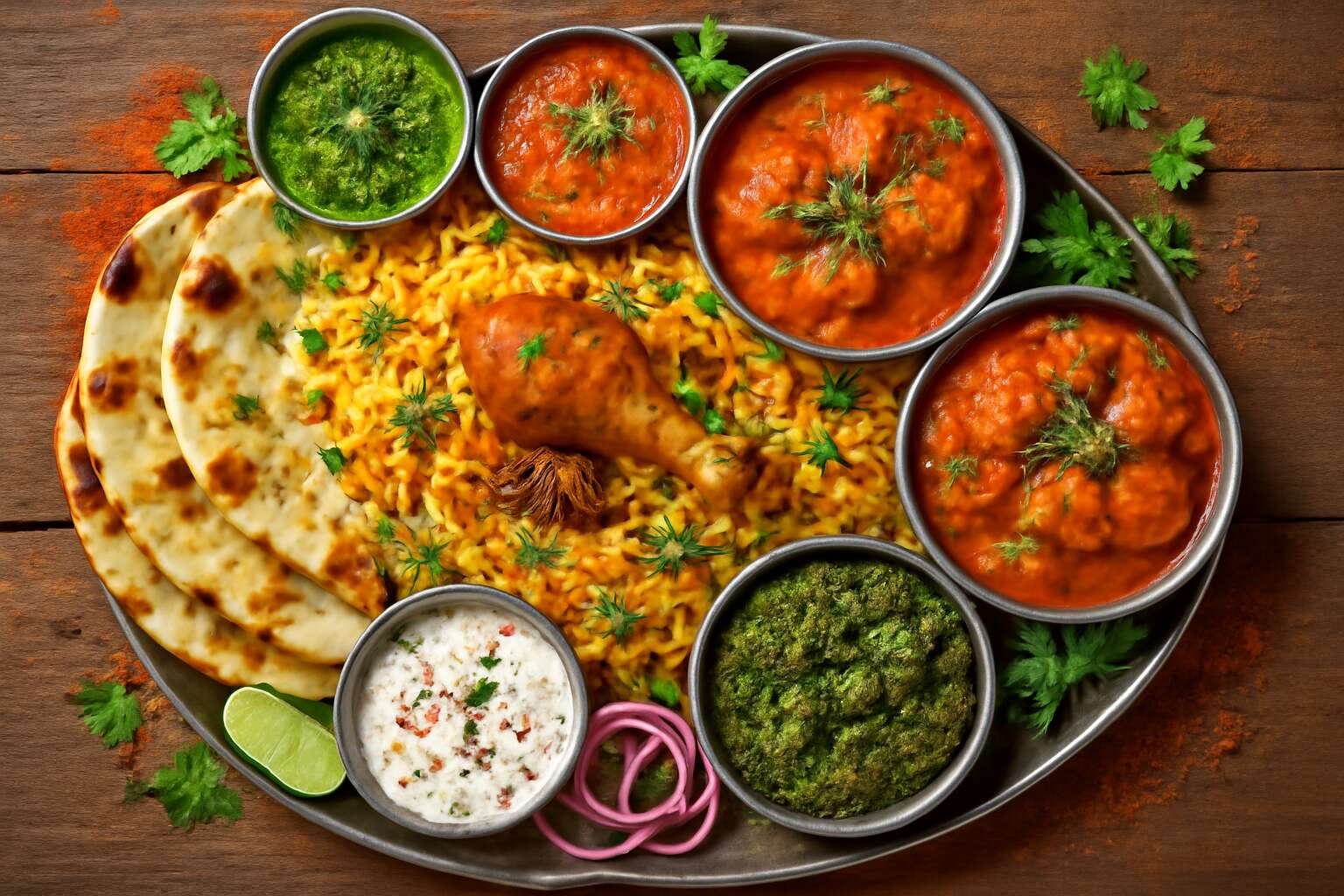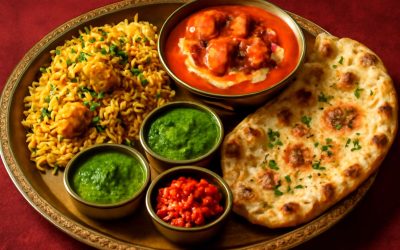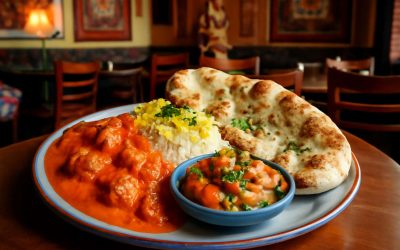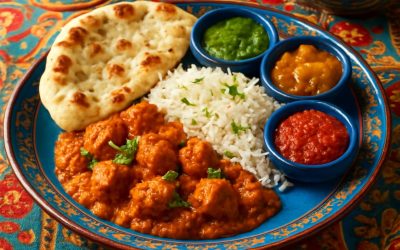The Rich Cultural Heritage of Indian Cuisine
Historical influences shaping Indian food – Overview of historical trade routes, invasions, and cultural exchanges
The rich cultural heritage of Indian cuisine is a tapestry woven with centuries of historical influences that have shaped what is so special about Indian food. From ancient trade routes to invasions and cultural exchanges, each chapter in India’s history has left an indelible mark on its culinary landscape. The Silk Road, for example, was not only a conduit for silk and spices but also a bridge that introduced flavours, ingredients, and culinary techniques from Persia, Central Asia, and beyond.
Invasions by the Mughals, Persians, and Portuguese further enriched Indian food, bringing new spices, cooking styles, and ingredients that continue to define regional identities today. The Mughal era, in particular, gifted India with the fragrant, complex dishes of Mughlai cuisine, renowned for their aromatic gravies and delicate biryanis.
To truly appreciate what is so special about Indian food, one must recognise its layered history—an ongoing dialogue between tradition and innovation that makes Indian cuisine a vibrant, ever-evolving culinary adventure.
Diverse regional cuisines – North Indian, South Indian, Eastern, Western, and Central Indian culinary styles
Indian cuisine isn’t just a meal; it’s a vibrant mosaic of flavours, aromas, and traditions that varies dramatically from region to region. When pondering what is so special about Indian food, one cannot ignore its rich tapestry of diverse regional cuisines. From the fiery spices of North India to the coconut-infused curries of the South, each culinary style offers a unique flavour profile that reflects local history, climate, and culture.
North Indian dishes often boast hearty gravies, naan bread, and an array of dairy-based delights like paneer. In contrast, South Indian cuisine is renowned for its dosas, idlis, and tangy sambar, often prepared with rice and lentils. Eastern Indian food features subtle, sweet, and mustard-infused dishes, while Western Indian cuisine is famous for its spicy, tangy flavours and vegetarian specialties. Central Indian cuisine acts as a melting pot, blending influences from neighbouring regions into a flavourful, eclectic mix.
In essence, each regional style contributes to the colourful culinary mosaic that makes Indian food so extraordinary. It’s an ongoing dialogue between tradition and innovation, constantly evolving yet rooted in centuries-old culinary artistry. That’s what makes Indian cuisine a truly fascinating, ever-changing gastronomic journey that keeps food lovers coming back for more!
Festivals and special occasions – How celebrations influence traditional Indian dishes
Indian cuisine is a living tapestry woven from centuries of tradition, spirituality, and communal celebration. Festivals such as Diwali, Holi, and Navratri are not merely dates on a calendar—they are a sensory odyssey that profoundly shape the flavours and presentation of traditional Indian dishes. These occasions ignite a culinary fervour, transforming humble ingredients into elaborate feasts imbued with cultural symbolism and emotional resonance. During Diwali, for instance, sweets like ladoos and halwa take centre stage, crafted with painstaking reverence to invoke prosperity and joy. Holi, with its riotous colours and exuberance, inspires colourful sweets and spiced drinks that mirror the festival’s vibrancy.
Celebrations influence Indian food in ways that transcend mere sustenance, elevating it to an art form rooted in spiritual symbolism and communal identity. The rich heritage of Indian cuisine is reflected in the meticulous preparation of special dishes, each carrying stories of ancient rituals and regional customs. From the fragrant biryanis of the Mughal era to the delicate sweets of Bengali festivities, each dish is a testament to the enduring cultural dialogue that makes Indian food so special. It’s this intricate interplay of tradition, emotion, and culinary mastery that keeps the flavour of Indian celebrations alive—an ever-evolving testimony to what is so special about Indian food.
Unique Ingredients and Spices in Indian Cooking
Signature spices and their flavors – Turmeric, cumin, coriander, garam masala, cardamom, and more
Indian cuisine is renowned for its complex tapestry of flavours, which stems from a carefully curated selection of unique ingredients and spices. These elements are not just flavour enhancers but are integral to the very identity of Indian food. When you ask what is so special about Indian food, the answer often lies in its masterful use of spices like turmeric, cumin, coriander, garam masala, and cardamom. Each of these ingredients carries a story — from turmeric’s vibrant hue and anti-inflammatory properties to cumin’s earthy aroma that adds depth to every dish.
Signature spices in Indian cooking often evoke a sense of mystique, weaving together centuries of tradition and regional variation. For example, garam masala, a warm and aromatic spice blend, can vary from region to region, creating a unique flavour profile that is both comforting and complex. The layering of these spices results in dishes that are not only flavourful but also imbued with cultural significance, making Indian food a culinary adventure unlike any other.
Use of herbs and fresh produce – Cilantro, mint, mango leaves, and others
Indian cuisine captivates the senses not just through its iconic spices but also via a vibrant palette of herbs and fresh produce. These ingredients breathe life into each dish, elevating flavour and aroma to a divine status. Imagine the zing of freshly chopped cilantro or the cool, refreshing burst of mint — these aren’t just garnishes; they are essential to what is so special about Indian food.
In addition, the use of mango leaves, holy basil, and curry leaves adds a layer of depth and tradition that is hard to find elsewhere. They often serve as natural flavour enhancers, imparting subtle nuances that transform everyday ingredients into culinary masterpieces. For instance, mango leaves are believed to bring positive energy and are used in many festive preparations, illustrating how Indian food intertwines with cultural spirituality.
- Fresh herbs like coriander and mint are used generously to balance spice and add brightness.
- Seasonal produce such as tomatoes, eggplants, and green peas are integral to regional dishes, each telling its own story.
This reliance on fresh ingredients creates a sensory symphony that is both wholesome and unforgettable. The careful selection and layering of herbs and produce are what truly make Indian food stand out — revealing a culinary artistry rooted in centuries of tradition and cultural richness.
The importance of spice blends – Complex flavor profiles created by masalas and pilafs
Indian food isn’t just about hot curries or hefty naan; it’s a sensory adventure crafted through a symphony of unique ingredients and spices that dance on the palate. What is so special about Indian food lies in its masterful use of spice blends—these aren’t your run-of-the-mill seasonings. Instead, they are complex, aromatic concoctions like garam masala, a fragrant mix of cumin, coriander, and cinnamon that elevates everything it touches. Indian cuisine often relies on these versatile spice blends to create layers of flavour that keep even the most seasoned foodies hooked.
Consider the art of making a pilaf, where a harmonious blend of spices—perhaps a pinch of cardamom or a dash of turmeric—turns simple rice into a fragrant masterpiece. These spices aren’t just flavour enhancers; they carry cultural significance, tying each dish to centuries of tradition. The careful balance of heat, sweetness, and earthiness in Indian spices reveals a culinary artistry that’s truly one-of-a-kind, making it clear why the question “what is so special about indian food” is answered with a flavourful explosion every time.
Distinctive Culinary Techniques and Cooking Methods
Slow cooking and simmering – Layering flavors through slow-cooked dishes like biryanis and dals
Indian cuisine’s allure often lies in its mastery of distinctive culinary techniques, especially slow cooking and simmering. These methods are the heartbeat of dishes like biryanis and dals, where patience transforms simple ingredients into rich, layered masterpieces. The gentle simmering process allows the flavours of spices, herbs, and aromatics to meld seamlessly, creating a depth that quick-cooking methods simply cannot replicate.
Through slow cooking, each ingredient releases its essence, building complex flavour profiles that are both comforting and invigorating. For instance, in making a traditional biryani, rice is layered with marinated meat, fragrant spices, and fried onions, then cooked slowly to allow the flavours to infuse thoroughly. This technique exemplifies what is so special about Indian food — the art of layering tastes through time-honoured methods.
- Layering spices in stages for maximum aroma
- Using low heat for extended periods to deepen flavour
- Incorporating fresh herbs at strategic moments for brightness
These slow-cooked dishes aren’t just about taste; they evoke a sense of tradition and patience that embodies Indian culinary culture. The careful, deliberate process ensures each bite offers a harmonious balance of spice and subtlety, making Indian food a true celebration of flavour and craftsmanship.
Tandoori and clay oven cooking – Authentic grilling and roasting techniques
Indian cuisine’s magic lies in its mastery of distinctive culinary techniques that elevate simple ingredients into extraordinary dishes. Among these, the use of tandoori and clay oven cooking stands out as a hallmark of authentic Indian food. The tandoor, a traditional clay oven, imparts a unique smoky aroma and tender texture to dishes like chicken tikka and naan bread, infusing them with a flavour that cannot be replicated through conventional grilling. This method creates a charred, yet moist, exterior that seals in the spices and juices, delivering an unparalleled sensory experience.
What is so special about Indian food is how it employs these grilling and roasting techniques to develop complex layers of flavour. The intense heat of the tandoor allows for rapid cooking while preserving the freshness of herbs and spices, enhancing the dish’s aromatic profile. Often, chefs utilise flavourful marinades and spice rubs before roasting, ensuring each bite bursts with depth and richness. The process exemplifies how traditional methods can produce culinary artistry that celebrates patience, craftsmanship, and cultural heritage.
Fermentation and pickling – Preserving flavors and enhancing taste
What is so special about Indian food lies not only in its kaleidoscope of flavours but also in its masterful use of fermentation and pickling—an age-old tradition that transforms humble ingredients into culinary treasures. These ancient techniques serve as both preservation methods and flavour enhancers, elevating everyday produce into complex gustatory symphonies. The tangy zip of pickled mangoes, the subtle fermentation of idli batter, and the pungent allure of Indian achar exemplify how these processes deepen taste profiles and extend shelf life.
Fermentation and pickling in Indian cuisine are more than mere preservation; they are an art form that imparts a distinctive sourness and richness, harmonising with the bold spices and herbs characteristic of Indian dishes. This method creates a layered flavour experience, adding depth and a touch of intrigue to meals. From fiery chutneys to fermenting dals, each technique embodies a cultural craftsmanship that celebrates patience and tradition. The resulting dishes burst with an authentic vibrancy, making Indian food uniquely captivating in the global culinary landscape.
Health Benefits and Nutritional Aspects of Indian Food
Use of holistic ingredients – Spices with medicinal properties
Indian cuisine is a symphony of holistic ingredients, where spices transcend their culinary role to become potent medicinal allies. Turmeric, often dubbed the golden healer, boasts anti-inflammatory properties that support joint health and bolster immunity. Cumin, with its warm aroma, aids digestion and helps regulate blood sugar levels, illustrating how each spice is imbued with health benefits that elevate Indian food beyond mere sustenance.
The use of fresh herbs such as cilantro and mint not only imparts vibrant flavours but also delivers detoxifying effects, enriching the body’s natural defences. Indian dishes often incorporate ingredients like mango leaves and green chilies, which are believed to have antimicrobial and antioxidant properties, further enhancing the nutritional profile of the cuisine.
Elegant spice blends like garam masala encapsulate centuries of medicinal wisdom, creating complex layers of flavour that simultaneously nurture health. This integration of healing ingredients exemplifies what is so special about Indian food—its ability to nourish both the soul and the body, through a tapestry of flavours rooted in ancient holistic traditions.
Vegetarian and vegan options – Rich plant-based dishes and their nutritional value
Indian cuisine is a treasure trove of health benefits, especially its abundant vegetarian and vegan options. Rich in plant-based ingredients, these dishes are not only vibrant and flavourful but also packed with essential nutrients that support overall wellness. Lentils, chickpeas, and a colourful array of vegetables form the foundation of many traditional Indian meals, providing high-quality protein, fibre, vitamins, and minerals.
What is so special about Indian food is how it seamlessly combines taste with nutrition. For instance, dishes like dal and vegetable curries are slow-cooked to preserve their nutrients while developing complex flavours. Incorporating ingredients such as spinach, eggplant, and tomatoes, Indian vegetarian dishes often feature antioxidants and anti-inflammatory compounds, contributing to better health outcomes. Additionally, the use of spices like turmeric and cumin enhances not only the taste but also offers anti-inflammatory and digestion-aiding properties.
To illustrate, a typical vegetarian thali might include a variety of pulses, grains, and fresh herbs—each element designed to optimise nutritional value. The utilisation of wholesome, plant-based ingredients makes Indian food stand out as a culinary tradition that champions health, vitality, and sustainability. Truly, exploring what is so special about Indian food reveals a rich tapestry of flavours that nourish both body and soul in equal measure.
Balancing flavors and nutrients – The concept of Ayurveda influence on meal preparation
Indian cuisine is renowned not just for its vibrant colours and intoxicating aromas, but also for its profound focus on health and balance. At the heart of this culinary tradition lies the ancient wisdom of Ayurveda, which influences meal preparation by emphasising harmony between taste and nutrition. Every dish is carefully crafted to optimise well-being, blending flavours that stimulate the senses while nourishing the body.
One of the remarkable aspects of Indian food is how it seamlessly combines medicinal herbs and spices—such as turmeric, cumin, and coriander—into everyday meals. These ingredients are celebrated for their anti-inflammatory, antioxidant, and digestive properties. For instance, turmeric’s bright hue signals its powerful role in reducing inflammation, while cumin aids in digestion and nutrient absorption. This natural synergy ensures that each bite contributes to overall health, making Indian food a delicious form of medicine.
Furthermore, Indian cuisine employs slow-cooking techniques that preserve nutrients and deepen flavours. The layering of spices through carefully prepared masalas creates complex, balanced dishes that deliver both taste and health benefits. This approach exemplifies what is so special about Indian food: its ability to nourish and delight simultaneously, turning every meal into a holistic experience that honours both tradition and wellness.
Indian Food Presentation and Dining Etiquette
Traditional serving styles – Thali meals, banana leaves, and communal dining
Indian food presentation is an art that elevates the dining experience into a sensory journey. Traditional serving styles like the iconic Thali meal encapsulate this philosophy perfectly—offering a harmonious array of dishes on a single platter, each with its own story and flavour profile. The vibrant colours, intricate arrangements, and fragrant aromas create an inviting tableau that beckons diners to explore the depths of Indian cuisine.
Another fascinating aspect of what is so special about Indian food is its utilisation of traditional serving vessels such as banana leaves and brass plates. These not only enhance flavour but also uphold eco-friendly practices rooted in centuries-old customs. Communal dining, often seen during festivals and special occasions, fosters a sense of unity and shared celebration that is central to Indian culinary culture. In many regions, meals are served with hands, respecting age-old etiquette that emphasises mindfulness and connection to the food. This holistic approach to presentation and dining etiquette transforms a simple meal into an immersive cultural experience, revealing why Indian food remains endlessly captivating and rich in tradition.
Cultural significance of food presentation – Color, aroma, and artistry in plating
Indian food presentation is an art form that transcends mere nourishment, transforming each meal into a visual and sensory masterpiece. The vibrant colours, intricate arrangements, and fragrant aromas are not just aesthetic choices—they are deeply rooted in cultural significance, creating an immersive experience that celebrates tradition and artistry. When exploring what is so special about Indian food, the emphasis on colour and aroma plays a pivotal role in captivating diners and elevating the dining experience.
Traditional serving vessels such as banana leaves and brass plates are more than functional; they are integral to the cultural fabric of Indian cuisine. These eco-friendly vessels enhance flavours and foster a sense of connection with centuries-old customs. The act of serving food in these authentic utensils often accompanies communal dining—an essential aspect of Indian hospitality—where sharing meals fosters unity and shared celebration. In many regions, the ritual of eating with hands accentuates mindfulness, making each bite a conscious indulgence. This holistic approach to presentation and etiquette reveals why what is so special about Indian food lies in its ability to intertwine culinary artistry with cultural depth, transforming a simple meal into a memorable celebration of tradition and community.
Eating customs – Use of hands, sharing dishes, and hospitality practices
Indian food isn’t just about nourishment; it’s an immersive tapestry woven with centuries of tradition, artistry, and cultural reverence. What is so special about Indian food is its unique approach to presentation and dining etiquette, which elevates every meal into a sensory celebration. The act of eating with hands, for instance, isn’t merely a tradition but a mindful ritual that connects diners deeply with each bite, amplifying flavours and fostering a sense of unity. This tactile engagement exemplifies the holistic philosophy inherent in Indian cuisine, where the senses—touch, smell, sight—are harmoniously intertwined.
Sharing dishes is integral to Indian dining customs, transforming a meal into a communal experience that embodies warmth and hospitality. Often, the spread is served on traditional vessels like banana leaves or brass plates, which are more than eco-friendly utensils—they are carriers of cultural identity. These vessels not only accentuate the aroma and flavours of the food but also enhance the overall aesthetic, making each dining experience a visual and aromatic delight. When served in such authentic settings, Indian food becomes a celebration of community, history, and artistry, revealing why it holds a cherished place in the hearts of so many.
Global Popularity and Adaptation of Indian Cuisine
Indian restaurants worldwide – The spread of authentic and fusion Indian dishes
Indian cuisine has transcended borders to become a global phenomenon, captivating palates with its vibrant flavours and complex spice profiles. Its widespread popularity can be seen in the countless Indian restaurants across continents, each offering authentic and innovative fusion dishes. This culinary adaptability demonstrates what is so special about Indian food — its versatility and appeal to diverse tastes.
From traditional curries to modern reinterpretations, Indian dishes have been embraced worldwide, often tailored to local preferences. Many chefs incorporate regional ingredients and cooking techniques, creating a unique blend of tradition and innovation. The proliferation of Indian restaurants showcases how this cuisine continues to evolve while retaining its core identity. Whether it’s a classic butter chicken or a contemporary masala burger, Indian food’s global footprint is undeniable.
Furthermore, Indian cuisine’s adaptability is reflected in its array of vegetarian and vegan options, appealing to a broad spectrum of diners. This flexibility, combined with the use of fresh herbs and bold spices, makes Indian food not just delicious but also inclusive. No wonder the world continues to celebrate what is so special about Indian food — a colourful tapestry of history, culture, and culinary mastery that resonates worldwide.
Modern takes and innovations – Contemporary twists on traditional recipes
Indian cuisine’s global popularity is nothing short of remarkable, with its vibrant flavours and intricate spice profiles captivating taste buds across continents. What is so special about Indian food is its remarkable ability to adapt and innovate while honouring centuries of culinary tradition. Modern takes on classic dishes have emerged, blending age-old recipes with contemporary culinary trends. Chefs worldwide experiment with fusion concepts, creating dishes like masala burgers or turmeric-infused pizzas, showcasing Indian food’s versatility.
This culinary evolution reflects a deep-rooted flexibility that allows Indian cuisine to cater to diverse palates. Incorporating regional ingredients and innovative cooking techniques, modern Indian dishes often boast a colourful array of flavours and textures. For example, traditional slow-cooked curries now feature in innovative formats, while street food staples are reimagined with a gourmet twist. This continuous reinvention underscores what is so special about Indian food—its ability to remain rooted in tradition yet embrace change with flair.
Furthermore, Indian cuisine’s adaptability extends to its vegetarian and vegan offerings. Dishes rich in fresh herbs and aromatic spices appeal to health-conscious diners seeking nourishing, plant-based options. Spices such as turmeric, cumin, and garam masala not only add depth but also elevate the nutritional value—highlighting how Indian food marries flavour with wellness. With its penchant for balancing complex spice blends and embracing modern dietary preferences, Indian cuisine’s innovative spirit ensures it remains a beloved culinary phenomenon worldwide.
Indian street food culture – Chaat, dosas, pani puri, and their worldwide influence
Indian street food culture has transcended borders, captivating palates across the globe with its vibrant offerings like chaat, dosas, and pani puri. These quintessential snacks are more than just fast bites; they embody a symphony of flavours, textures, and colours that evoke a sense of culinary adventure. Their influence is evident in bustling food markets worldwide, where the aroma of spices and freshly fried snacks beckon curious food lovers.
What is so special about Indian food is how seamlessly it adapts to diverse culinary landscapes. From innovative fusion dishes to gourmet reinterpretations of street classics, Indian cuisine proves its versatility time and again. International chefs are experimenting with Indian street food staples, elevating them into sophisticated dishes that appeal to contemporary tastes. This ongoing culinary dialogue ensures that Indian food remains both rooted in tradition and refreshingly innovative.
In many cities, you’ll find modern takes on traditional Indian dishes, where the authenticity of flavours is preserved while presentation and technique are given a contemporary twist. The global popularity of these dishes not only highlights their universal appeal but also underscores Indian cuisine’s ability to evolve while honouring its rich heritage. Whether it’s a street-side pani puri or a refined masala dosa, Indian food’s charm lies in its unpredictable fusion of history, innovation, and cultural vibrancy.




0 Comments